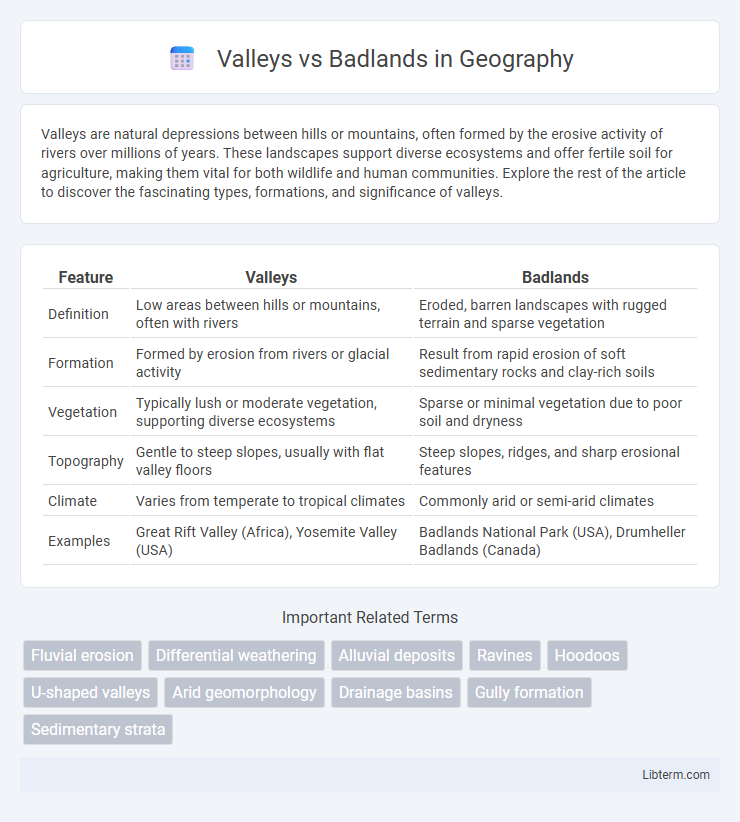Valleys are natural depressions between hills or mountains, often formed by the erosive activity of rivers over millions of years. These landscapes support diverse ecosystems and offer fertile soil for agriculture, making them vital for both wildlife and human communities. Explore the rest of the article to discover the fascinating types, formations, and significance of valleys.
Table of Comparison
| Feature | Valleys | Badlands |
|---|---|---|
| Definition | Low areas between hills or mountains, often with rivers | Eroded, barren landscapes with rugged terrain and sparse vegetation |
| Formation | Formed by erosion from rivers or glacial activity | Result from rapid erosion of soft sedimentary rocks and clay-rich soils |
| Vegetation | Typically lush or moderate vegetation, supporting diverse ecosystems | Sparse or minimal vegetation due to poor soil and dryness |
| Topography | Gentle to steep slopes, usually with flat valley floors | Steep slopes, ridges, and sharp erosional features |
| Climate | Varies from temperate to tropical climates | Commonly arid or semi-arid climates |
| Examples | Great Rift Valley (Africa), Yosemite Valley (USA) | Badlands National Park (USA), Drumheller Badlands (Canada) |
Introduction to Valleys and Badlands
Valleys are low-lying areas between hills or mountains, typically formed by river erosion and characterized by fertile soil and varied vegetation. Badlands are heavily eroded, barren landscapes with steep slopes, sparse vegetation, and sedimentary rock formations that create rugged terrain. Both landforms represent distinctive geological processes shaping Earth's surface, with valleys supporting diverse ecosystems while badlands often indicate arid conditions and rapid erosion.
Defining Valleys: Key Characteristics
Valleys are elongated low areas between hills or mountains, typically formed by river erosion or glacial activity, featuring fertile soil and accessible water sources that support diverse ecosystems. They often have gentle slopes and serve as natural pathways for human settlement, agriculture, and transportation due to their relatively mild terrain. Unlike the barren, rugged badlands, valleys possess lush vegetation and a more stable climate conducive to sustained life and economic activity.
Understanding Badlands: Unique Features
Badlands are characterized by steep slopes, minimal vegetation, and heavily eroded terrain formed from easily disintegrated sedimentary rocks such as clay and shale. Their unique features include intricate networks of ravines, sharp ridges, and dramatic erosion patterns caused by intense water runoff and sparse plant cover, distinguishing them sharply from the more gently sloped, vegetated valleys. These geological formations often provide rich fossil beds and reveal stratified rock layers that offer valuable insights into ancient environments.
Geological Formation Processes Compared
Valleys form primarily through the erosional action of rivers and glaciers, carving out depressions in the Earth's surface over millions of years, often resulting in V-shaped or U-shaped profiles depending on the dominant erosional force. Badlands arise from rapid erosion of soft sedimentary rocks like clay and shale, with sparse vegetation accelerating weathering and creating steep slopes, intricate ridges, and gullies. While valleys reflect continuous fluvial or glacial sculpting, badlands show episodic erosion influenced by semi-arid to arid climates that prevent soil stabilization.
Climate and Weather Patterns
Valleys typically experience moderate climate conditions with more stable temperatures and higher humidity due to their lower elevation and water flow presence. Badlands exhibit extreme weather patterns, characterized by rapid temperature fluctuations, low precipitation, and intense erosion caused by sparse vegetation and arid climate. These contrasting climate dynamics significantly influence soil composition and ecosystem diversity in valleys versus badlands.
Flora and Fauna in Valleys vs Badlands
Valleys typically support a diverse range of flora such as deciduous trees, shrubs, and grasses, providing habitats for animals like deer, foxes, and songbirds. Badlands, characterized by sparse vegetation including hardy grasses, cacti, and drought-resistant shrubs, host specialized wildlife such as lizards, snakes, and small mammals adapted to arid, rugged conditions. The ecological contrast highlights valleys as rich, biodiverse environments compared to the more extreme, xeric ecosystems of badlands.
Erosion and Soil Composition Differences
Valleys form primarily through long-term erosion by rivers cutting through bedrock and sediment, resulting in deeper, more fertile soils rich in organic material. In contrast, badlands develop from rapid erosion of soft, clay-rich soils and sedimentary layers, producing highly erodible landscapes with sparse vegetation and poor soil cohesion. These differences in erosion processes and soil composition drive the distinct topographies and ecological characteristics of valleys and badlands.
Human Activities and Land Use
Valleys often support diverse human activities such as agriculture, residential development, and transportation due to their fertile soils and access to water sources, making them hubs of economic and cultural activity. Badlands, characterized by their rocky terrain and sparse vegetation, are less suitable for traditional farming or urban development but are valuable for mining, fossil excavation, and tourism. Land use in valleys prioritizes cultivation and habitation, while badlands are preserved for scientific research and recreational purposes, reflecting their distinct environmental constraints and potentials.
Notable Examples Worldwide
Notable valley examples include the Grand Canyon in the United States, which showcases extensive river-formed erosion, and the Rift Valley in East Africa, known for its tectonic activity and rich biodiversity. Famous badlands such as the Badlands National Park in South Dakota highlight heavily eroded, barren landscapes with unique sedimentary formations, while the Drumheller Badlands in Canada offer striking fossil-rich terrain with distinctive hoodoos. These regions demonstrate contrasting geological processes and ecological characteristics, with valleys typically featuring water flow channels and badlands representing dry, sculpted terrains.
Conclusion: Which Landscape Prevails?
Valleys and badlands each showcase unique geological features shaped by erosion and sedimentation, yet valleys prevail as more habitable and ecologically diverse landscapes. Valleys, formed by river activity, support rich soil and vegetation, fostering agriculture and human settlement. In contrast, badlands exhibit harsh, rugged terrain with limited vegetation, making them less suitable for sustained life and development.
Valleys Infographic

 libterm.com
libterm.com